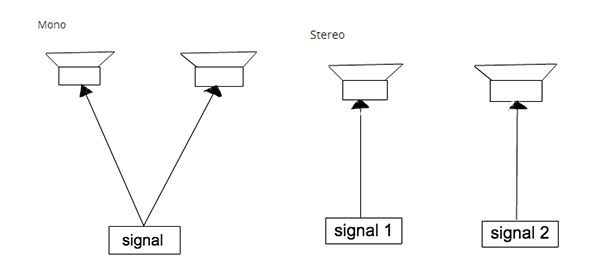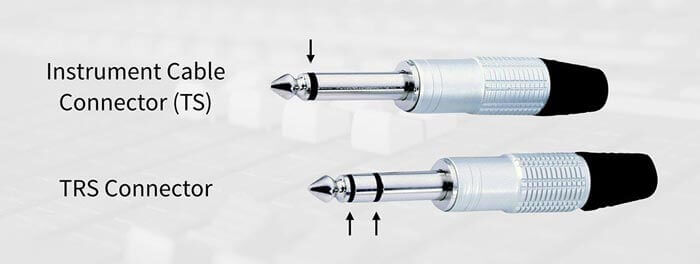Certainly this is one of the most common questions regarding audio theory. Learning this difference is a basic piece knowledge for those who wish to become professionals in the field of music, audio, mixing, sound engineering, or for those who simply want to understand how recording works. Mono stands for monophonic, stereo is the abbreviation of stereophonic. When we discuss mono vs stereo, more than just considering the number of speakers or sound sources, we must think about identical signals versus distinct signals. If we always take this into account, surely an analysis will lets us tell these terms apart. So, stay tuned, because we'll approach this subject extensively, but objectively.
Summary
If you already know this and just want to refresh your memory, we made a short summary for you!- There are three different things to consider: system, signal and components.
- A stereo recording has mono components, and they form the central image.
- Having two speakers doesn't mean you have a stereo signal.
- It's impossible to reproduce a stereo signal with only one speaker. It will either be the two channels summed into one, or, if we only connect one side of the stereo, only that side will be reproduced.
- TRS cables don't necessarily carry stereo signals. This may be the case for headphone outputs, but not for interface inputs and outputs. These are mono outputs and support TRS cables as they provide balanced signals.
- Inputs and outputs on the interface are all compatible with TS cables. The signal won't be balanced, but it will work nonetheless.
- A stereo recording only with mono components is, in practice, the same as a mono recording.
Requirements
We play something recorded in mono on our computers, and the sound comes through both speakers. An instrument, such as a guitar, is a mono instrument and thus recorded in mono, and yet the sound also come out from both speakers. We change the setting on our TV from stereo to mono, and we still hear sound coming from both speakers. But, isn't mono when we have sound coming through only one speaker? This is what causes the greatest confusion when we talk about mono vs stereo; and it comes from not knowing the difference between a mono or stereo signal and a mono or stereo system. So let's get some basic principles out of the way, before actually discussing mono vs stereo :Mono system x Stereo system
- Mono System: Is composed of only one speaker. Normally positioned up front.
- Stereo System: Is made up of a pair of speakers. In it's correct stereo setting, the distance between the two speakers should be the same as the distance between you and each of them. Forming an equilateral triangle, with a 60 degree angle towards the speaker. This is the correct stereo positioning.

Mono signal x Stereo signal
- Mono signal: Only carries one signal within it. Even if we run this mono signal through a pair of speakers, since the signal is one, both will inevitably play the same information.
- Stereo signal: It contains two signals. So, it can carry distinct information between them. In other words, while the "Left" channel may be reproducing a certain sound, the "Right" signal may be playing something completely different. They are completely independent. And when we say completely, we mean 100% independent. Stereo reads as complete independence between channels and their sound information.
Signal summing
The concept behind summing signals is: You have two signals and you sum them as one. The summed signal will be a mixture of the the elements from the signals added together. Regarding the sum, it can happen in two ways. These two signals can be:- Electrically summed: We can visualize this better if we imagine two wires or cables, each carrying a different signal, which we then join together. We call this electrical summing. Then, if we connect this cable into a speaker, it will reproduce the the signals altogether, as one. Nowadays, this form of summing can be made through a computer or an audio editing program (DAW, Digital audio Workstation). Technically, this sum is little different than soldering the wires, but for our purpose of explaining signal sum, it will work perfectly.
- Acoustically summed: If we have two speakers, even though each of them is playing something different, we can hear both at the same time. And we can hear individual elements from both of them at the same time. This means that, in our ears and brains, we sum the signals acoustically. This happens specially in a stereo system. Since both speakers are the same distance away from you, neither of the signals will take longer than the other to reach your ears.
Joining concepts
Let's consider a stereo signal for the following examples. In other words, we have a pair os distinct signals. Our system may be mono or stereo, and the sum of our signals may be acoustic or electric. Let's see each of these combinations:- Mono System, electric summing: We sum signals before they travel to the speaker which will reproduce the summed sound; which is a mix of both signals.
- Stereo System, electric summing: Our stereo signal will be summed before traveling to the speakers. Each speaker will receive and reproduce the same joined signal, which is a mixture of both signals. In other words, there is no different information being played by either one. Both will reproduce the exact same summed signal.
- Mono System, acoustic summing: It can't be done. For acoustic summing to happen, two sound sources are needed; mono system is, by definition, made of one single speaker. If we played one of our signals through our mono system, a remaining signal wouldn't be linked to a speaker. In the end we would be only playing one channel of the stereo signal.
- Stereo System, acoustic summing: This is what happens when we play music. A music file has two channels which are completely separate (left and right). If we reproduce this file through a stereo system, each speaker will play one of these independent signals. Thus, we can have different information being played at once. It is summed acoustically and we listen to the music, which is the acoustic sum of both signals. Keep this in mind when you read the next section.

On the left, one single signal going to a stereo setup with two speakers. On the right, independent signals, each going to one speaker.
Components: mono vs stereo
Consider last example of the section above: a stereo system, reproducing a stereo signal, along with inevitable acoustic summing. OK then... We play a song through both speakers simultaneously. If we put our ears near each of them in turn, we can hear the singer's voice from either of them, no matter which one. This means that there is voice coming from both speakers. But didn't you say the signals were distinct? If they are, why do we receive identical information coming from both sides? That is a good question. That is exactly from where the concept of components shows up, one of the last points to clear before fully understanding mono vs stereo. Let's consider for our next example, the last scenario from the situation above: we play a stereo signal, through a stereo system (consequently, acoustic summing).- Mono Component: It's any identical sound coming from both speakers as the recording or stereo signal plays the sound. But only those sound bits need to be 100% identical on both sides, ok? In terms of volume (amplitude), of phase, of effects.
- Stereo Component: It's any sound which isn't a mono component. In other words, you have a bit of information on one side, which doesn't exist on the other or exists but has a different balance, this is a stereo component. If one element of the song has a "55/45" volume balance between the left and right channels, we consider it a stereo component, even though it's "almost in balance". Either it is perfectly identical, or else it is a stereo component.
Do mono signals also have components?
"Component" is a term we apply only to stereo signals, since inevitably all the sounds in a mono recording are mono (therefore, mono components). What's important to know is that, when working with a stereo signal, part of the sound can be mono while another can be stereo. Since stereo is 100% independent and anything can come out of any of the speakers, at any given moment, a mono component illustrates when two identical signals are played at the same time. In other words, even though both channels are completely separate and have the power to play completely independent signals, nothing prevents them to contain some identical information. In mixing, voice is commonly mixed in the "center". This means it is perfectly balanced between the two channels. This makes it a mono component inside a stereo recording.Central Image
When we reproduce a stereo signal through a stereo system, but the signal includes a mono component, we inevitably create a central image. Central image is a phenomenon that occurs when we play a mono component through a stereo system. Due to physics and psychoacoustics, we notice a "ghost" in the space between each stereo speaker, as if the sound was coming from between them. Any mono component reproduced through a stereo system will form a central image. So, if your signal is mono and you're reproducing through a stereo setup, 100% of the sound will make up the central imaging. However, if we have a stereo signal, which contains both mono and stereo components, we will only have a portion of our recording making up the central imaging. Nowadays, mainstream music is all about mono components. There's no way to put this in percentage, but one can say about 70% or more of the sound information in modern pop recordings are mono components. In other words, it's almost all in center. This is a phenomenon which only happens if the set up of the stereo system is 60º or close to it. Other and angles may cause this effect to dim or disappear. This central image won't happen if we listen through headphones, because it's a psychoacoustic effect, and we need an acoustic summing of signals for it to happen.Cables: mono vs stereo
We all heard one dat that the TS cable is "P10 Mono" and that the TRS is a "P10 Stereo". So, it's fair that we think that one carries mono signals while the other carries stereo, right? Unfortunately, this is a common misunderstanding and makes the mono vs stereo understanding much more confusing than it should. The name comes from the fact that, in order to transmit a stereo signal, we need at least 3 contacts; and the TRS has exactly 3. However, just because we have a cable with 3 contacts, it doesn't necessarily mean the signal going through it is stereo. The most common case in which TRS cables carry stereo signals are in headphone outputs. Mobiles, iPods, Aux cables, Audio interface headphone outputs. Be it P10 or P2, a headphone cable carries two channels, one for each speaker. This is a stereo signal.
Balanced Signals
In almost any other usage, TRS cables will be transmitting mono signals. The most common scenario is when working with balanced signals. We use balanced signals because they are less subject to interference caused by the exposure of long cables through air. However, to carry a signal in balance, we also need a cable with at least 3 contacts. For this use, the most common cables are XLR and TRS, both with 3 contacts each. However, balanced signals are Mono. We sacrifice the second channel in order to create a copy of the original signal, which is needed to make the magic happen. So, every TRS carrying a balanced signal is carrying in fact a mono balanced signal. If we want a balanced stereo, we need two separate TRSs, each with a balanced mono signal. In professional audio, we know that most connections are balanced. Audio interface outputs and inputs. Peripherals. Rack equipments. All these inputs support balanced signals and their outputs are able to provide balanced signals. However, The inputs will accept an unbalanced signal if you connect it through a TS, just like the outputs will send out the signal in its unbalanced form if you use a TS cable going out. When we refer to supporting "balanced connections", we are actually saying that they "are capable of accepting and producing balanced signals".
In short, if we run our balanced outputs into our monitors using TRS cables, each of them will have a TRS cable connected to it. Each speaker will be receiving a mono signal, balanced. That one signal is a channel; one of the sides of the stereo. (one receiving the "R" and the other receiving the "L")
In professional audio, we know that most connections are balanced. Audio interface outputs and inputs. Peripherals. Rack equipments. All these inputs support balanced signals and their outputs are able to provide balanced signals. However, The inputs will accept an unbalanced signal if you connect it through a TS, just like the outputs will send out the signal in its unbalanced form if you use a TS cable going out. When we refer to supporting "balanced connections", we are actually saying that they "are capable of accepting and producing balanced signals".
In short, if we run our balanced outputs into our monitors using TRS cables, each of them will have a TRS cable connected to it. Each speaker will be receiving a mono signal, balanced. That one signal is a channel; one of the sides of the stereo. (one receiving the "R" and the other receiving the "L")

